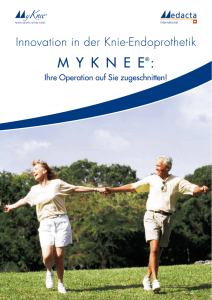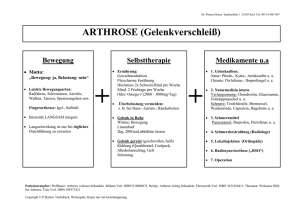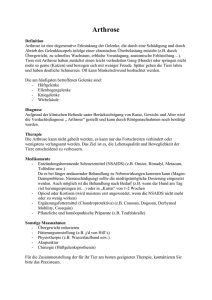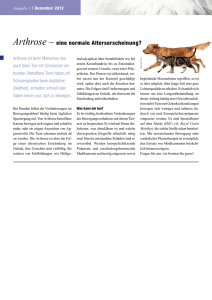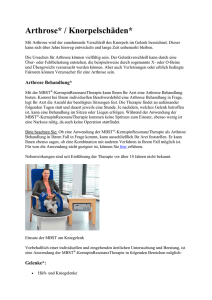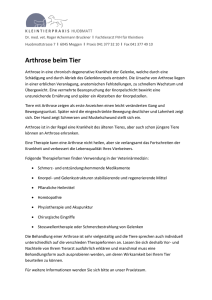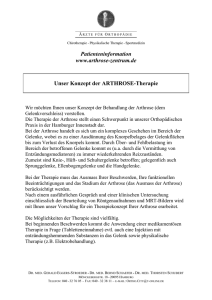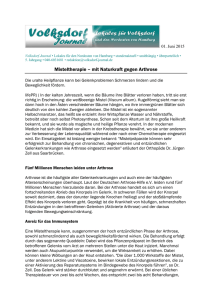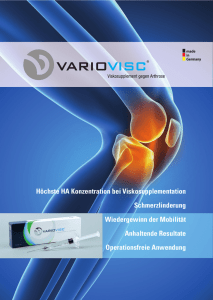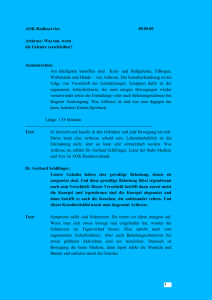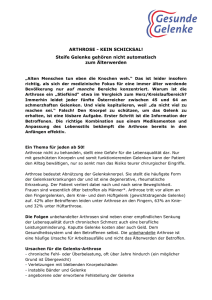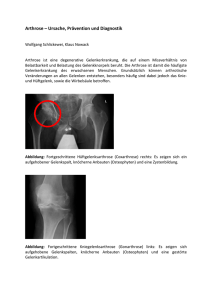Das OxfordKnie in der Literatur
Werbung
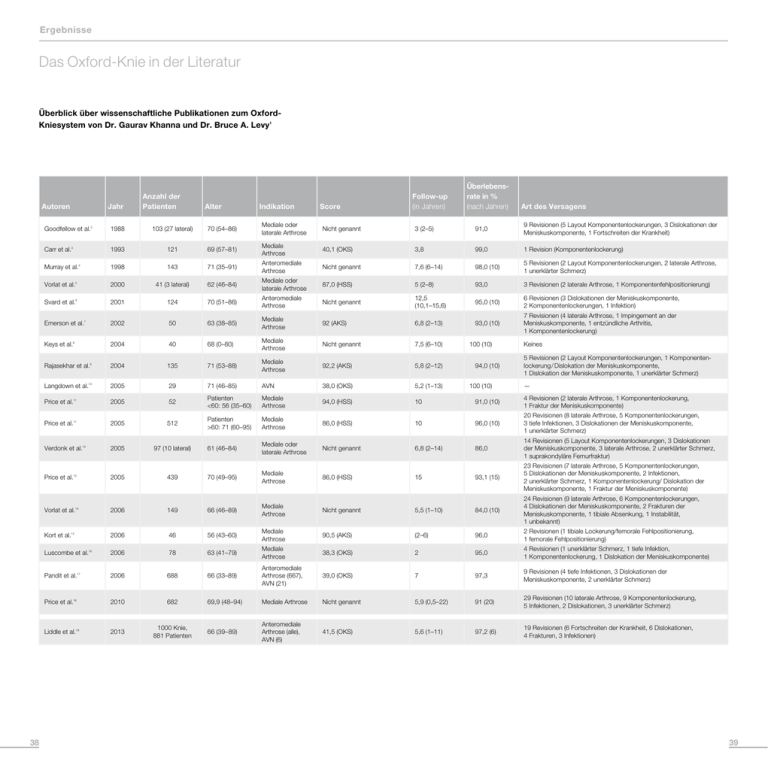
Ergebnisse Das Oxford-Knie in der Literatur Überblick über wissenschaftliche Publikationen zum OxfordKniesystem von Dr. Gaurav Khanna und Dr. Bruce A. Levy1 Autoren Jahr Alter Indikation Score Follow-up (in Jahren) Überlebensrate in % (nach Jahren) Art des Versagens Goodfellow et al.2 1988 103 (27 lateral) 70 (54–86) Mediale oder laterale Arthrose Nicht genannt 3 (2–5) 91,0 9 Revisionen (5 Layout Komponentenlockerungen, 3 Dislokationen der Meniskuskomponente, 1 Fortschreiten der Krankheit) Carr et al.3 1993 121 69 (57–81) Mediale Arthrose 40,1 (OKS) 3,8 99,0 1 Revision (Komponentenlockerung) Murray et al.4 1998 143 71 (35–91) Anteromediale Arthrose Nicht genannt 7,6 (6–14) 98,0 (10) 5 Revisionen (2 Layout Komponentenlockerungen, 2 laterale Arthrose, 1 unerklärter Schmerz) Vorlat et al.5 2000 41 (3 lateral) 62 (46–84) Mediale oder laterale Arthrose 87,0 (HSS) 5 (2–8) 93,0 3 Revisionen (2 laterale Arthrose, 1 Komponentenfehlpositionierung) Svard et al.6 2001 124 70 (51–86) Anteromediale Arthrose Nicht genannt 12,5 (10,1–15,6) 95,0 (10) 6 Revisionen (3 Dislokationen der Meniskuskomponente, 2 Komponentenlockerungen, 1 Infektion) Emerson et al.7 2002 50 63 (38–85) Mediale Arthrose 92 (AKS) 6,8 (2–13) 93,0 (10) 7 Revisionen (4 laterale Arthrose, 1 Impingement an der Meniskuskomponente, 1 entzündliche Arthritis, 1 Komponentenlockerung) Keys et al.8 2004 40 68 (0–80) Mediale Arthrose Nicht genannt 7,5 (6–10) Rajasekhar et al.9 2004 135 71 (53–88) Mediale Arthrose 92,2 (AKS) 5,8 (2–12) Langdown et al.10 2005 29 71 (46–85) AVN 38,0 (OKS) 5,2 (1–13) Mediale Arthrose 94,0 (HSS) 10 91,0 (10) 4 Revisionen (2 laterale Arthrose, 1 Komponentenlockerung, 1 Fraktur der Meniskuskomponente) 100 (10) 94,0 (10) 100 (10) Keines 5 Revisionen (2 Layout Komponentenlockerungen, 1 Komponenten­ lockerung / Dislokation der Meniskuskomponente, 1 Dislokation der Meniskuskomponente, 1 unerklärter Schmerz) — 11 Price et al. 2005 52 Patienten <60: 56 (35–60) Price et al.11 2005 512 Patienten >60: 71 (60–95) Mediale Arthrose 86,0 (HSS) 10 96,0 (10) 20 Revisionen (8 laterale Arthrose, 5 Komponentenlockerungen, 3 tiefe Infektionen, 3 Dislokationen der Meniskuskomponente, 1 unerklärter Schmerz) Verdonk et al.12 2005 97 (10 lateral) 61 (46–84) Mediale oder laterale Arthrose Nicht genannt 6,8 (2–14) 86,0 14 Revisionen (5 Layout Komponentenlockerungen, 3 Dislokationen der Meniskuskomponente, 3 laterale Arthrose, 2 unerklärter Schmerz, 1 suprakondyläre Femurfraktur) 70 (49–95) Mediale Arthrose 93,1 (15) 23 Revisionen (7 laterale Arthrose, 5 Komponentenlockerungen, 5 Dislokationen der Meniskuskomponente, 2 Infektionen, 2 unerklärter Schmerz, 1 Komponentenlockerung/ Dislokation der Meniskuskomponente, 1 Fraktur der Meniskuskomponente) Nicht genannt 5,5 (1–10) 84,0 (10) 24 Revisionen (9 laterale Arthrose, 6 Komponentenlockerungen, 4 Dislokationen der Meniskuskomponente, 2 Frakturen der Meniskuskomponente, 1 tibiale Absenkung, 1 Instabilität, 1 unbekannt) Price et al. 13 2005 439 86,0 (HSS) 15 Vorlat et al. 2006 149 66 (46–89) Mediale Arthrose Kort et al.15 2006 46 56 (43–60) Mediale Arthrose 90,5 (AKS) (2–6) 96,0 2 Revisionen (1 tibiale Lockerung/femorale Fehlpositionierung, 1 femorale Fehlpositionierung) Luscombe et al.16 2006 78 63 (41–79) Mediale Arthrose 38,3 (OKS) 2 95,0 4 Revisionen (1 unerklärter Schmerz, 1 tiefe Infektion, 1 Komponentenlockerung, 1 Dislokation der Meniskuskomponente) Pandit et al.17 2006 688 66 (33–89) Anteromediale Arthrose (667), AVN (21) 39,0 (OKS) 7 97,3 9 Revisionen (4 tiefe Infektionen, 3 Dislokationen der Meniskuskomponente, 2 unerklärter Schmerz) Price et al.18 2010 682 69,9 (48–94) Mediale Arthrose Nicht genannt 5,9 (0,5–22) 91 (20) 29 Revisionen (10 laterale Arthrose, 9 Komponentenlockerung, 5 Infektionen, 2 Dislokationen, 3 unerklärter Schmerz) Liddle et al.19 2013 1000 Knie, 881 Patienten 66 (39–89) Anteromediale Arthrose (alle), AVN (6) 41,5 (OKS) 5,6 (1–11) 97,2 (6) 19 Revisionen (6 Fortschreiten der Krankheit, 6 Dislokationen, 4 Frakturen, 3 Infektionen) 14 38 Anzahl der Patienten 39 Ergebnisse Weitere Studien Referenzen: Khanna, G. and Levy, B. Oxford Unicompartmental Knee Replacement: Literature Review. Orthopedics Supplement. 30(5): 12. 2007. 1 Goodfellow, J. et al. The Oxford Knee for Unicompartmental Osteoarthritis. The First 103 Cases. J Bone Joint Surg 70:692–701. 1998. 2 3 Carr, A. et al. Medial Unicompartmental Arthroplasty: A Survival Study of the Oxford Meniscal Knee. Clin Orthop 295:205–213. 1993. 4 Murray, D. et al. The Oxford Medial Unicompartmental Arthroplasty. A Ten-Year Survival Study. J Bone Joint Surg 80:983–989. 1998. Vorlat, P. et al. The Oxford Unicompartmental Knee Prosthesis: A 5-Year Follow-up. Knee Surgery Sports Traumatology Arthroscopy. 8:154–158. 2000. 5 Svard, U. and Price, A. Oxford Medial Unicompartmental Knee Arthroplasty. A Survival Analysis of an Independent Series. J Bone Joint Surg Br. 83:191–194. 2001. 6 7 Indikation „Für einen unikondylären Teilgelenkersatz sind laut WillisOwen, Cobb et al 47,6% aller Patienten mit der Indikation für eine Knieendoprothese geeignet. Bei weiteren 31,4 % kam die UKEP zumindest in Frage.“ Willis-Owen CA, Brust K, Alsop H, Miraldo M, Cobb JP. Unicon­ dylar knee arthroplasty in the UK National Health Service: An ana­ lysis of candidacy, outcome and cost efficacy. ScienceDirect. The Knee 16. 473–478. 2009 Emerson, R. et al. Comparison of a Mobile with a Fixed-Bearing Unicompartmental Knee Implant. Clin Orthop 404:62–70. 2002. Keys, G. et al. Analysis of First Forty Oxford Medial Unicompartmental Knee Replacements from a Small District Hospital in UK. Knee. 11:375–377. 2004. 8 Rajasekhar, C. et al. Unicompartmental Knee Arthroplasty. 2-to 12-year Results in a Community Hospital. J Bone Joint Surg Br. 86:983–985. 2004. 9 10 Langdown, A. et al. Oxford Medial Unicompartmental Arthroplasty for Focal Spontaneous Osteonecrosis of the Knee. Acta Orthopaedica. 76:688–692. 2005. 11 Price, A. et al. Oxford Medial Unicompartmental Knee Arthroplasty in Patients Younger and Older Than 60 Years of Age. J Bone Joint Surg Br. 87:1488–1492. 2005. Verdonk, R. et al. The Oxford Unicompartmental Knee Prosthesis: A 2-14 Year Follow-up. Knee Surgery Sports Traumatology Arthroscopy. 13:163–166. 2005. Patientenzufriedenheit „Im Rahmen einer Patientenumfrage zeigte sich deutlich, dass Patienten mit einer Oxford-Prothese zufriedener sind als Patienten mit einer Totalendoprothese.“ Biomet Oxford vs. TKA Satisfaction Survey. März 2012 12 Price, A. et al. Long-term Clinical Results of the Medial Oxford Unicompartmental Knee Arthroplasty. Clin Orthop 435:171–180. 2005. 13 Vorlat, P. et al. The Oxford Unicompartmental Knee Prosthesis: An Independent 10-year Survival Analysis. Knee Surgery Sports Traumatology Arthroscopy. 14:40–45. 2006. 14 Kort, N. et al. The Oxford Phase III Unicompartmental Knee Replacement in Patients Less than 60 Years of Age. Knee Surgery Sports Traumatology Arthroscopy. 2006. 15 16 Luscombe, K. et al. Minimally Invasive Oxford Medial Unicompartmental Knee Arthroplasty. A Note of Caution! International Orthopaedics. 2006. Pandit, H. et al. The Oxford Medial Unicompartmental Knee Replacement Using a Minimally-invasive Approach. J Bone Joint Surg 88B: 54–60, 2006. 17 Price, AJ, Svard U. A Second Decade Lifetable Survival Ananlysis of the Oxford Unicompartmental Knee Arthroplasty. Clin Orthop Relat Res. 2010 Aug 13. 18 19 Liddle AD, Pandit H, O‘Brien S, Doran E, Penny ID, Hooper GJ, Burn PJ, Dodd CA, Beverland DE, Maxwell AR, Murray DW. Cementless fixation in Oxford unicompart­mental knee replacement: a multicentre study of 1000 knees. J Bone Joint Surg 2013;95-B: 181–7 „Die Rate der Patienten, die über ein normales Kniegefühl berichteten, lag beim Oxford-Knie um den Faktor 1,8 höher. Die Wahrscheinlichkeit, dass der Patient mit seiner Fähigkeit zum Ausführen alltäglicher Aktivitäten zufrieden ist, war 2,7-mal größer als bei KTEP.“ Washington University Study, vorgestellt auf dem CCJR Spring Meeting 2013 in Las Vegas „Patienten mit einer unikondylären Versorgung profitieren von einem natürlicheren Bewegungsablauf.“ Deshmukh, RV, Scott, RD. Unicompartmental knee arthroplasty: long term results. Clinical Orthopedics and Related Research. 2001; 392:272278. „Patienten mit einer unikondylären Versorgung profitieren von einem größeren Bewegungsumfang.“ Lombardi, A. et al. Is Recovery Faster for Mobile-bearing Unicom­ partmental than Total Knee Arthroplasty? Clinical Orthopedics and Related Research.467:1450–57. 2009. „Patienten mit unikondylärer Versorgung profitieren davon, dass Komplikationen seltener vorkommen und weniger schwer ausfallen als bei KTEP. Auch Infektionsrisiko und Morbidität sind geringer.“ Brown, NM, et al. Total Knee Arthroplasty Has Higher Postopera­ tive Morbidity Than Unicompartmental Knee Arthroplasty: A Multi­ center Analysis. The Journal of Arthroplasty, 2012. 40 41
